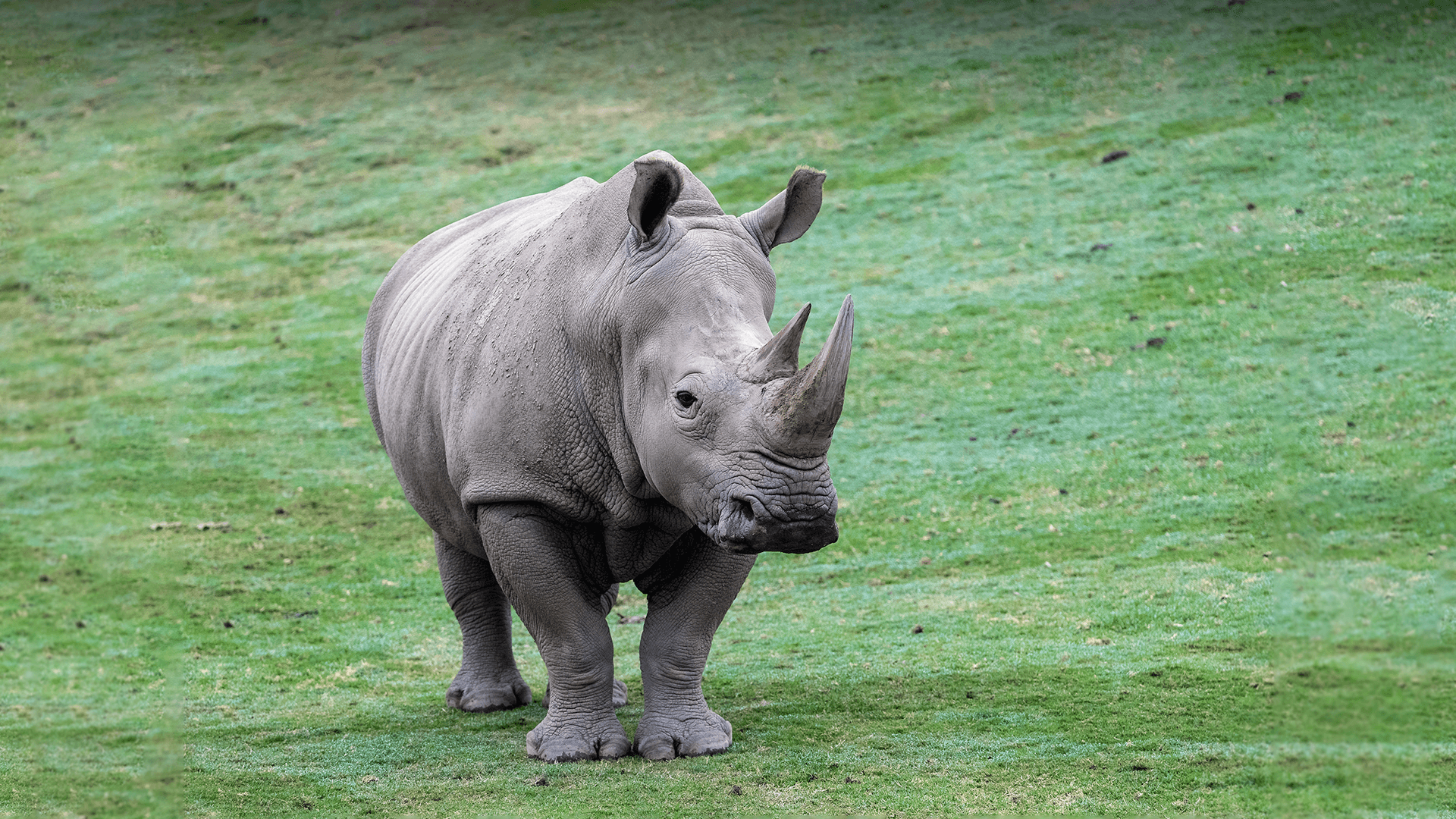
White Rhinoceros

- Class: Mammalia (Mammals)
- Order: Perissodactyla
- Family: Rhinocerotidae
- Genus: Ceratotherium
- Species: simum
- Subspecies: C.s. simum (southern), C.s. cottoni (northern)

ABOUT
Vanishing giants. The classic vision of an African savanna would be incomplete without rhinoceroses, colossal icons of their grassland homes. White rhinos Ceratotherium simum, in particular, are known for their formidable size. While large and tough-appearing, white rhino populations are fragile. Demand for their horns has led to rampant poaching and plummeting populations. Just two northern white rhinos C.s. cottoni remain in the world. Southern white rhinos C.s. simum are more abundant, but still in dire need of conservation action to protect their future.
White rhinos have two horns on the end of their nose, with a larger front horn and a small inner horn. Rhino horns don’t have a bony core like other mammal horns. The outside is rather hard but can be worn down or sharpened after years of use. If a horn breaks off, it can gradually grow back. Rhino horns are made of keratin, the same material that makes up our fingernails and hair.
Like other rhinos, white rhinos have a broad chest, thick skin, poor eyesight, and excellent hearing. Because rhinos are nearsighted, they often charge when startled. This defense mechanism has given them an undeserved reputation for having a bad temper. Their ears can move independently of each other, and one may be cocked forward while the other is directed backward, or both may perk straight up when an interesting sound that requires total concentration is detected.
Despite their name, white rhinos are gray in color. How the white rhino came to be called “white” is uncertain. One account says that it comes from the Dutch word wijde, or “wide,” referring to the white rhino’s wide lip or large size.
HABITAT AND DIET
Shrinking habitat. While once abundant throughout sub-Saharan Africa, white rhinos now live in small pockets of southern Africa, in long and short-grass savanna and shrubland habitats.
Chow down: White rhinos are herbivorous. Their broad, square lip is built for grazing. As they eat, they crop grasses so short that they create “grazing lawns” that benefit smaller plant-eating wildlife and serve as firebreaks. At the San Diego Zoo Safari Park, rhinos eat fresh grass, grass hay, and grains.
FAMILY LIFE
Home turf: Dominant male rhinos occupy small territories. They only allow one or two subordinate males to share the territory. Neighboring dominant males respect one another’s space and rarely trespass, except to reach water during the dry season. Adult white rhino females are more social, often staying in groups of up to a dozen that include calves and subadults. A group of rhinos is known as a “crash.”
Females enter a dominant male’s territory when they are ready to mate. White rhino males can be persistent about courtship, pursuing females for 5 to 20 days. A male approaches a female with a series of breathy “hic-pant” vocalizations, and may rest his chin on her rump to see if she's receptive to mating. If successful, she gives birth to a calf 15 to 16 months later.
Like other rhinos, white rhinos make a variety of sounds to communicate with others. Long and short snorts are used to express anger or alarm. When startled, high-pitched screams indicate fear. A deep, resonant “mmwonk” means that they are content.
Smelly signals. Dominant male rhinos spend much of their time patrolling their territory and marking it with urine and dung, to communicate with neighboring rhinos. Subordinate males put little effort into such communication with scent, always deferring to the dominant male when they meet up.
AT THE ZOO
The San Diego Zoo Safari Park began caring for southern white rhinos in 1971. In this time, we’ve had the honor of caring for a growing crash and have welcomed more than 100 southern white rhino calves.
The world’s only two remaining northern white rhinos live at Kenya’s Ol Pejeta Conservancy. Both are female, making them functionally extinct.
CONSERVATION
White rhinos’ large size protects them from savanna predators like lions and cheetahs. Sadly, it's people who pose the biggest threat to white rhinos’ survival. While rhinos have an excellent sense of smell, their poor eyesight makes them an easy target for poachers.
Hunted for horn: White rhinos once roamed widely across sub-Saharan Africa without much threat from other wildlife, thanks to their immense build. But the advent of high-powered weapons brought a new enemy: people. Rhino horn—which is made of keratin, like our fingernails and hair—has been used for centuries in folk medicine, but has not proven to cure any illness. Some people also view items made from rhino horns as status symbols because of their rarity. Both practices drive demand for rhino horns, leading to poaching and rapidly shrinking rhino populations. Many African countries have implemented measures to prevent poaching and protect rhinos, but the demand continues to rise, and poaching remains a substantial problem.
Hope for white rhinos: Currently, southern white rhinos are listed as Near Threatened and northern white rhinos are listed as Critically Endangered on the International Union for Conservation of Nature (IUCN) Red List of Threatened Species. San Diego Zoo Wildlife Alliance collaborates with international partners to help protect and save white rhinos worldwide. With more than 100 calves born at the San Diego Zoo Safari Park, we are a world leader in white rhino conservation.
You can help save wildlife worldwide by joining us today as an ally for wildlife.
SIZE
Length: Up to 16 feet, from head to tail
Weight: 1.6 to 4 tons (4,000 to 6,000 pounds)
Weight at birth: 88 to 132 pounds (40 to 60 kilograms)
LIFE SPAN
About 37 years on average
YOUNG
Gestation: 16 months
Number of young at birth: One
Age of maturity: 6.5 to 7 years for females; 10 to 12 years for males
FUN FACTS
White rhinos are tied with greater one-horned rhinos as the second-largest land mammals; only elephants trump them in size.
Like other rhinos, white rhinos wallow in watery depressions in the earth to cover their skin in mud, which acts as a natural sunscreen and insect repellent.










